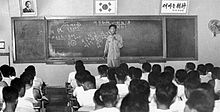New Community Movement
| Saemaul Undong | |
 |
|
| Korean name | |
|---|---|
| Hangul | |
| Hanja | 새마을 |
| Revised Romanization | Saemaeul undong |
| McCune–Reischauer | Saemaŭl undong |
The Saemaul Undong, also known as the New Community Movement, New Village Movement, Saemaul Movement or Saema'eul Movement, was a political initiative launched on April 22, 1970 by South Korean president Park Chung-hee to modernize the rural South Korean economy. The idea was based on the Korean traditional communalism called Hyangyak (향약) and Doorae (두레), which provided the rules for self-governance and cooperation in traditional Korean communities. The movement initially sought to rectify the growing disparity of the standard of living between the nation's urban centres, which were rapidly industrializing, and the small villages, which continued to be mired in poverty. Diligence, self-help and collaboration were the slogans to encourage community members to participate in the development process. The early stage of the movement focused on improving the basic living conditions and environments whereas later projects concentrated on building rural infrastructure and increasing community income. Though hailed as a great success in the 1970s, the movement lost momentum during the 1980s as the economic situation and political environment in South Korea changed rapidly.
The movement promoted self-help and collaboration among the people during its first phase, as the central government provided a fixed amount of raw materials to each of the participating villages free of charge and entrusted the locals to build whatever they wished with them. The government first selected 33,267 villages and provided 335 sacks of cement. 16,600 villages that demonstrated success were then granted additional resources of 500 sacks of cement and a ton of iron bars.
The New Community Movement did much to improve infrastructure in rural South Korea, bringing modernized facilities such as irrigation systems, bridges and roads in rural communities. The program also marked the widespread appearance of orange tiled houses throughout the countryside, replacing the traditional thatched or choga-jip houses. Encouraged by the success in rural areas, the movement spread through factories and urban areas as well, and became a nationwide modernization movement.
...
Wikipedia
